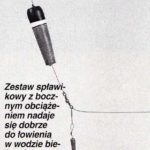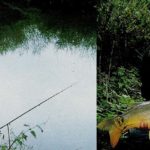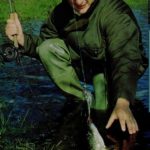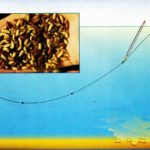Gdzie prąd rzeki zmienia kierunek, a woda krąży w miejscu, tam trzyma się dużo ryb, jednak bardzo trudno się je łowi. Jak wędkować na poruszającą się ciągle przynętę ciągniętą przez spławik opowie Wam John Bailey.
Łowienie na zestaw spławikowy w rzece jest niezwykle podniecające. Chociażby dlatego, że każde miejsce można obłowić na wiele sposobów. Mógłbym tu bez trudu wymienić i opisać przynajmniej dziesięć różnych metod, ograniczę się jednak tylko do mojej ulubionej techniki, a mianowicie do wędkowania w krążącej wodzie. Szkoda, ze jak dotąd tylko niewielu kolegów upodobało sobie właśnie tę metodę. Wędkowanie w krążącej wodzie na zestaw spławikowy to jeden z najskuteczniejszych sposobów łowienia prawie wszystkich gatunków ryb rzecznych. Przypomina to trochę łowienie z przynętą leżącą na dnie, jednak krążący zestaw penetruje znacznie większą powierzchnię. Spławik musi być dość duży. Grunt ustawia się na taką głębokość, aby przynęta i ciężarek swobodnie sięgały do dna. Przynęta nigdy nie leży jednak zbyt długo w jednym miejscu. Powoli krąży nad dnem, gdyż przemieszczający się spławik nieustannie ciągnie ją za sobą. Metoda ta wymaga co prawda pewnej wprawy, jest jednak bardzo efektywna. Potrzebne nam będzie dość długie wędzisko, przynajmniej 4-metrowe, łowi się zaś dość blisko brzegu, idealnym miejscem jest spokojne zakole rzeki z powoli krążącą wodą o głębokości od jednego do trzech metrów. Grunt ustawiamy zawsze trochę większy niż wynosi faktyczna głębokość łowiska (zależy to od szybkości prądu oraz głębokości w danym miejscu). Krążąca woda unosi spławik, który pociąga za sobą przynętę, a ta z kolei przemieszcza się nad dnem i aktywnie szuka ryb. Spławik jest przymocowany do żyłki dwupunktowo (na górze i na dole). Wędkę przez cały czas trzymamy uniesioną do góry, tak aby żyłka pomiędzy szczytówką a spławikiem była zawsze lekko naprężona. Jeżeli spławik zatrzyma się w jakimś miejscu pozwalamy mu poleżeć na wodzie przez pół lub nawet całą minutę, a następnie unosimy zestaw lekko do góry i ponownie pozwalamy spławikowi krążyć w prądzie wody. Brania są przeważnie bardzo dobrze widoczne. Łatwo je odróżnić od zaczepu na dnie, gdyż wtedy spławik bardzo wolno wchodzi pod wodę.
Czyste dno
W opisywanej przeze mnie metodzie bardzo dobrze sprawują się duże spławiki z piór oraz spławiki typu avon. Wielkość spławika zależy tylko od głębokości łowiska. Przynętą są przeważnie białe robaki, castery lub zagnieciony na haczyku miąższ chleba. Nęci się bardzo małymi kulkami zanętowymi rzucając je lekko pod prąd.
Aktywne łowienie w leniwie krążącej wodzie jest najskuteczniejsze jesienią i zimą, gdy pierwsze przymrozki oraz podwyższony stan wody oczyściły już dno łowiska z gnijącej roślinności wodnej. Metoda ta w pełni sprawdza się, gdy dno zakola rzeki jest idealnie czyste. Dopiero wtedy można liczyć na sukcesy. Wędkowanie na przepływankę, nawet w krążącej wodzie, zawsze sprawia sporo trudności. Najgorsze są fałszywe brania. Podczas łowienia w pobliżu dna haczyk zaczepia się o resztki roślinności, gałązki, korzenie i po chwili znika pod wodą. Po kilku zarzuceniach poznaje się jednak w miarę dokładnie łowisko, można się też zorientować, na które miejsca należy szczególnie uważać. Pomimo to spławik znika od czasu do czasu z gładkiej powierzchni wody, a to za każdym razem doprowadza mnie, do drżenia przedsionków serca. Jestem prawie pewny że to zaczep, gdyż spławik zbyt wolno chowa się pod wodą, a mimo wszystko zacinam.
Każde niepotrzebne zacięcie wprowadza niepokój w łowisku i płoszy ryby, a tego należy za wszelką cenę unikać. Zbyt dużo niepotrzebnych zacięć sprawia, że ryby uciekają z takiego miejsca. Jak więc łowić? Są tylko dwie możliwości: zacinać tylko pewne brania lub reagować zacięciem, bez zbytniego zastanawiania się przy każdym przytopieniu spławika. Jestem zwolennikiem pierwszej metody.









Bywa że spławiki leżą w wodzie i mimo dobrego dociążenia nadal źle się zachowują. Może komuś pomoże coś takiego że wtedy trzeba przetrzeć żyłkę zwykłym płynem do naczyń prawdopodobnie może być brudna i dlatego też spławik może leżeć w wodzie i nie stawać. Wiele osób na rybach wyrzuca dobry spławik bo myśli że się uszkodził a to bywa że wina żyłki a w zasadzie brudu na niej. Warto o tym też pamiętać.